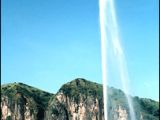On the night of August 21st, 1986, 80 million cubic meters of carbon dioxide (1.6 million tonnes of CO2) burst from the water of the volcanic Lake Nyos, killing by asphyxiation 1,700 persons and 3,600 livestock. The 50 m (166 ft) tall jet was made of gas (90%) and water. The gas had accumulated in the depths of the lake, coming from the magma below, dissolved in the water due to the high pressure exerted at 100-200 m (330-660 ft). The cause of the burst is unknown; it could have been due to a sudden raise of the water or an earthquake. The affected zone in northern Cameroon was enforced immediately as forbidden area.
A similar case had been signaled 2 years before at Lake Monoun, 100 km (62 mi) away of Nyos, killing 37 people. The only other lake in the world, besides these two, known to manifest a similar phenomenon is Lake Kivu (Rwanda). After the evacuation of the area, a French team started to investigate the place. In 1995, specialists proved at the place the possibility of using a quite simple system for degasing the water so that to turn the lake and the area non-dangerous for life.
Meanwhile, the lake started to reload itself, the gas amount approaching the saturation limit, when no intervention can be made without the risk of an explosion. By 2001, the concentration reached the value of 10 liters of gas at one liter of water, the limit being of 14 liters of gas at one liter of water.
On January30, 2001, the long operation of draining the killer lake started. The French team installed in the middle of the lake a first permanent column of degasing, at the depth of 205 m (680 ft). The bottom water filled with carbon dioxide ascends in the central tube with the help of a pump. During the ascend, the decreasing pressure releases the gas out of the water as bubbles, which increase progressively and push the water that bursts like a jet on the surface. Once switched on, the system works by itself, without energy consume.
The gear degases at a rhythm of 20 million cubic meters of gas annually. But the lake has large reserves of gas, about 300 million cubic meters, its refilling being made with 2-5 million cubic meter per year. The installed column, which will lose efficiency in time, will require 30-50 years to make the lake really non-dangerous. Another 3-4 columns would reduce the task to 4-5 years.

 14 DAY TRIAL //
14 DAY TRIAL // 
